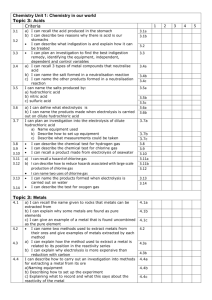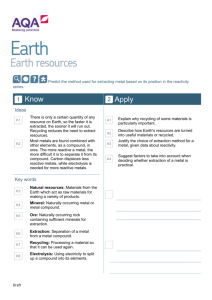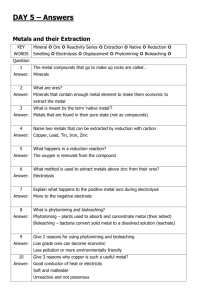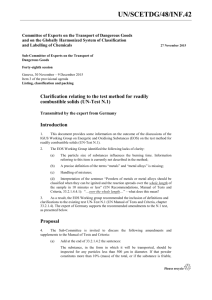5780-C1.3 & 4 Metal & acid QQT Cards
advertisement
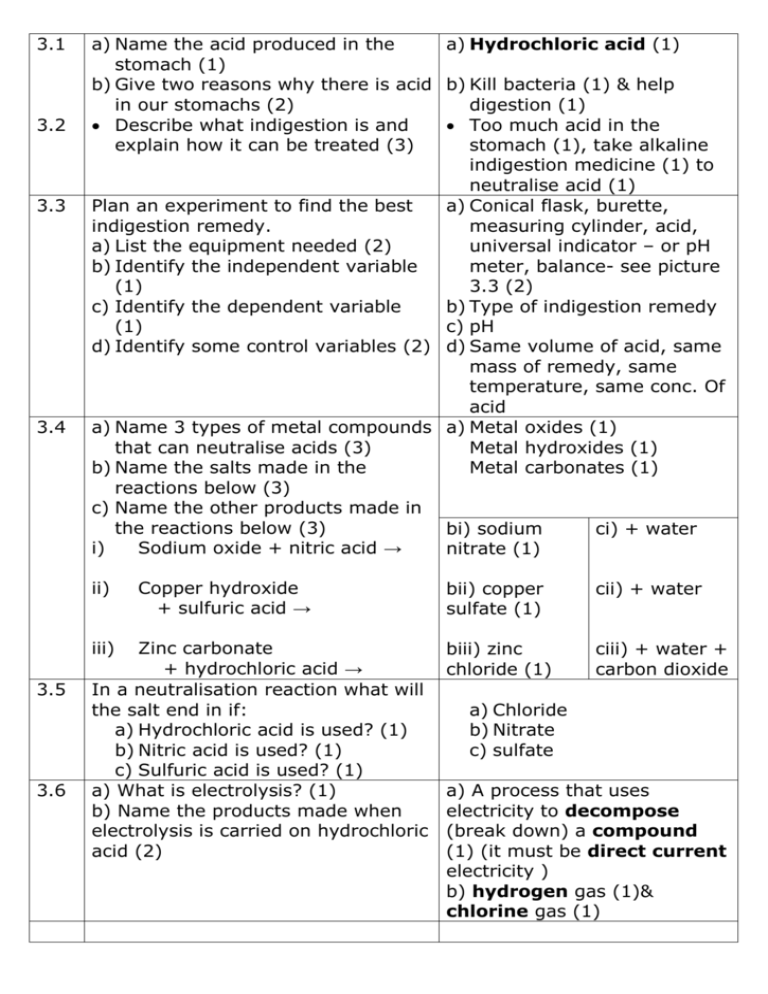
3.1 3.2 3.3 3.4 a) Name the acid produced in the a) Hydrochloric acid (1) stomach (1) b) Give two reasons why there is acid b) Kill bacteria (1) & help in our stomachs (2) digestion (1) Describe what indigestion is and Too much acid in the explain how it can be treated (3) stomach (1), take alkaline indigestion medicine (1) to neutralise acid (1) Plan an experiment to find the best a) Conical flask, burette, indigestion remedy. measuring cylinder, acid, a) List the equipment needed (2) universal indicator – or pH b) Identify the independent variable meter, balance- see picture (1) 3.3 (2) c) Identify the dependent variable b) Type of indigestion remedy (1) c) pH d) Identify some control variables (2) d) Same volume of acid, same mass of remedy, same temperature, same conc. Of acid a) Name 3 types of metal compounds a) Metal oxides (1) that can neutralise acids (3) Metal hydroxides (1) b) Name the salts made in the Metal carbonates (1) reactions below (3) c) Name the other products made in the reactions below (3) bi) sodium ci) + water i) Sodium oxide + nitric acid → nitrate (1) ii) iii) 3.5 3.6 Copper hydroxide + sulfuric acid → Zinc carbonate + hydrochloric acid → In a neutralisation reaction what will the salt end in if: a) Hydrochloric acid is used? (1) b) Nitric acid is used? (1) c) Sulfuric acid is used? (1) a) What is electrolysis? (1) b) Name the products made when electrolysis is carried on hydrochloric acid (2) bii) copper sulfate (1) cii) + water biii) zinc chloride (1) ciii) + water + carbon dioxide a) Chloride b) Nitrate c) sulfate a) A process that uses electricity to decompose (break down) a compound (1) (it must be direct current electricity ) b) hydrogen gas (1)& chlorine gas (1) 3.7 3.8 3.9 3.10 3.11 3.12 3.13 3.14 Plan an investigation into the a) Power pack, leads, crocodile electrolysis of dilute hydrochloric clips, beaker, carbon rods acid. (electrodes), acid, gas a) Name equipment used (2) collection tubes. b) Describe how to set up equipment b) Connect DC power supply to – a labelled diagram could be 2 carbon rods, put rods in a used. (2) beaker of hydrochloric c) Describe what measurement could acid, as shown below. be taken (1) c) Measure volume of gas given off (1) Describe the test for hydrogen gas Lit splint makes a squeaky (1) pop (1) Describe the test for chlorine gas Blue litmus paper goes (1) red then white (1) Name a product from the Chlorine gas (1) electrolysis of sea water (1) a) Name the hazard associated with a) Toxic (can kill you) (1) chlorine gas (1) b) Describe how to reduce hazards b) Ensure the gas does not associated with large scale escape, sealed container (1) production of chlorine gas. (1) I can name two uses of chlorine Bleach (1), polyvinyl gas (2) chloride (a type of plastic) (1) Name the products formed when Hydrogen gas (1), oxygen electrolysis is carried out on water gas (1) (2) Describe the test for oxygen gas Glowing splint is relit (1) (1) 4.1 4.2 4.3 4.4 a) What name is given to rocks that metals can be extracted from (1) b) Explain why some metals are found as pure elements (1) c) Name a metal that is found as the pure element Name two methods used to extract metals from their ores and give examples of metals extracted by each method (4) a) Explain how the method used to extract a metal is related to its position in the reactivity series b) Explain why electrolysis is more expensive than reduction with carbon(2) Describe how to carry out an investigation into methods for extracting metals from its ore a) Name equipment needed (2) b) Describe how to set up the experiment (2) c) What would you record and what would this tell you about the reactivity of the metal?(2) 4.5 4.6 4.7 Define the terms oxidation and reduction (2) I can name the general type of reaction that produces metals from metal ores (1) Name a problem caused when metals are oxidised (1) a) Ores (1) b) Some metals are so unreactive they do not form compounds (1) c) Gold (1) Reduction with carbon (1), example iron (1) and electrolysis (1), example aluminium (1) a) Metals below carbon in the reactivity series are extracted by reduction with carbon (1), metals above carbon are extracted using electrolysis b) Fuel burnt to produce heat to melt the ore (1) AND uses electricity to power the electrolysis a) Bunsen burner, tripod, gauze, crucible, metal oxide, carbon powder b) Measure set mass of metal oxide and carbon powder into the crucible. Put crucible on tripod over Bunsen burner and heat. c) Has a reaction taken place producing a metal? If yes the metal is less reactive than carbon. Oxidation is gaining oxygen (1), (eg carbon is oxidised to carbon dioxide) Reduction is the loss of oxygen (1) (eg Iron oxide is reduced to iron) Reduction (1) Corrosion (1) 4.8 4.9 4.10 4.11 4.12 4.13 Describe how a metals reactivity is The lower in the reactivity linked to its position in the series a metal is the less reactivity series. (1) likely it is to corrode.(1) Describe the advantages of (eg gold is unreactive and recycling metals (4) does not corrode) Saves raw materials & helps to preserve metal ores (1), less energy used to recycle (1), less waste goes to land fill (1), less carbon dioxide produced as less fuel burnt to release energy (1) Name a use for each metal below a) Drink cans- unreactive/ and link this to a property of the Aeroplanes- low density (1 metal: b) Wires- good conductor of a) Aluminium (1) electricity b) Copper (1) Pipes- unreactive (1) c) Gold (1) c) Jewellery- unreactive (1) d) Steel (1) d) Cars- strong (1) a) What is the definition for an alloy? a) Mixture of metals (1) b) Describe two properties that make b) Stronger (1) better alloys more useful than pure metals resistance to corrosion(1) Use a model to explain why alloys Different sized atoms from are harder than pure metals different elements (1), distort the regular layered structure (1), so its’ harder for layers of atoms to slide past each other (1) a) Describe how alloying changes a) Gold alloy is stronger than the properties of gold and pure gold (1),jewellery explain why this is useful (2) keeps it’s shape better (1) b) Describe special properties of b) They change shape when shape memory alloys heated or cooled past a Give an example of uses of threshold temperature (1) smart or shape memory alloys Braces for teeth (1) heat of like nitinol and explain how mouth changes metal shape their properties link to the use. to pull teeth into position (1)/ Stent- tube for keep a blood vessel open (1)- heat of body makes tube keep it’s shape (1)/ glasses frames (1)- return to original shape when heated slightly
